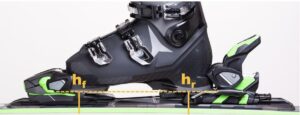Keywords: alpine skiing, ACL-injury, ski geometry, standing height
Authors: Irving Scher, Martin Burtscher and Gerhard Ruedl
Do ski geometry parameters impact ACL injury risk in alpine skiing?
We will explain in this blog skier characteristics and alpine (downhill) ski equipment factors associated with anterior cruciate ligament (ACL) injuries in alpine skiing. Our study (recently published in BJSM) examined injuries across six winter seasons and was a collaboration between the University of Innsbruck (Innsbruck, Austria), Sportclinic Medalp (Imst, Austria), the University College of Education (Stams, Austria), and the University of Washington (Seattle, USA).1
Why is this study important?
Alpine skiing is one of the most popular winter activities and has wide appeal, from families to adrenaline seekers. During falls or when a skier is out-of-control, a ski can act as a lever arm and produce injurious torques on the lower extremities, especially on the knee joint.
Unfortunately, improvements in the ski binding-boot systems have had little effect on knee injury rates over the past few decades, and the knee now represents the most prevalent injury location in skiing. As anterior cruciate ligament (ACL) tears are the most common ski-related knee injury, our latest research focused on understanding the skier and equipment factors related to ACL injuries.
How did the study go about this?
We gathered data from ACL-injured skiers and their equipment across six consecutive ski seasons at an Austrian ski area to examine the relationships between ski equipment parameters and ACL injuries. A questionnaire gathered information from skiers about anthropometry, skill, and risk-taking behavior. Equipment-related data (such as ski length, side-cut radius, and standing heights at the front or rear binding component) were recorded from the ski or measured directly. We specifically examined the pitch of the ski boot when it was in the binding and defined a new parameter called “standing height ratio” as the ratio of front and rear component heights. The standing height ratio was less than 100% when the front binding component was lower than the rear binding component with the boot pitched forward (Figure 1).


Figure 1: Standing heights of the front (hf) and rear (hr) ski binding components. The standing height ratio was calculated with the following formula [(hf/hr)*100%] and is represented by the dotted line.
What did the study find?
We found that skiers who sustained ACL injuries had different characteristics and equipment parameters when compared to non-injured skiers. Skiers with less experience skiing and those who reported taking more risks were 7 and 4 times more likely to sustain an ACL injury, respectively. Also, older skiers had a higher risk of ACL injury.
Ski-binding-boot parameters that were independent risk factors for an ACL injury included ski length, tip width, and standing heights. The shorter skis, reduced tip widths, and lower standing heights were associated with a reduced likelihood of ACL injury. Higher rear standing height and greater standing height ratio (a more horizontal ski boot sole position in the ski binding) had the most significant effects on ACL injury risk, with risk increasing by about 4 and 3 times, respectively.
What are the key take-home points?
Skiers can take some actions to reduce the chance of an ACL injury during recreational skiing. One such action is to dial back their risk-taking behaviors and improve their skills. In addition, using somewhat shorter skis (i.e., using skis with a narrower tip region) and reducing the rear standing height and standing height ratio could lower the chance of an ACL injury, which should be considered when buying or adjusting ski equipment.
References:
- Ruedl G, Posch M, Tecklenburg K, Schranz L, Greier K, Faulhaber M, Scher I, Burtscher M. Impact of ski geometry data and standing height ratio on the ACL injury risk and its use for prevention in recreational skiers. Br J Sports Med 2022; 10.1136/bjsports-2021-105221